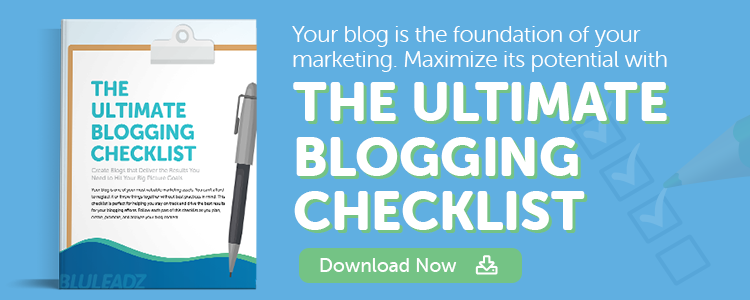We here at Bluleadz have been crafting up some awesome pillar pages to share with our audience and provide more value on lengthy topics – check out our first live pillar page about developing a Facebook marketing strategy!
During this process, we’ve learned a lot. From brainstorming and ideation to drafting, designing, and publishing, here are some of the biggest things we learned about creating pillar pages.
1. You Can’t Build a Pillar Page in a Day
This takeaway seems obvious to some, but when we first got stuck on the idea of adding pillar content to our website, we thought we could knock a bunch out and publish them all in a short amount of time.
Boy, were we wrong.
From beginning to end, our Facebook marketing pillar page took about two months to be published. A lot of impediments at the beginning kept us from diving head first into our pillar content; as we started building out our content, we still needed a design layout, and all our designers were already head-deep in client work.
But, in the end, we had time to really proofread and proofread again the content we had created. Once our design template was built out by one of our awesome designers, our content was well prepared to be plugged right in.
Takeaway: Take your time building out your content, designing the website page, and proofing your content. The less you push it to publication, the more accurate, informative, and successful your pillar content will be.
2. You Think You Finished Writing – But Then You Find More to Write About
Just when you think you’ve finished the writing process, you’ll probably find three more sections you have to add.
The hardest part about writing out pillar content is that it's supposed to be a more in depth piece of work about a broad topic – answer the who, what, when, where, why, how, and everything in between.
When we were proofing our first drafts of each chapter, we found areas that needed expanding, then more areas, then more. Overall, we added a lot more valuable content to our pillar pages just by going deeper into the topic and breaking each part up a little bit more.
Takeaway: Don't think you are done after the first draft. Make sure you are constantly assessing your work to find any weak points or areas that could use more explanation or examples.
3. Don't Try to Tackle Multiple Pillar Pages at a Time (as an Individual)
As a marketing specialist with a specialty in social media marketing, I began tackling four pillar pages all at once – a marketing strategy for Facebook, Instagram, Twitter, and LinkedIn.
Notice how only one of those four pillar pages is actually complete? By trying to write all of them at once, I wasn’t able to actually focus and learn more about one topic. Different strategies started running together, and I kind of got lost in the content.
Fast forward a few weeks, and I decided that it just wasn't working. Instead, I decided to put all of my attention toward one page to see it through to the end. Now that I have it out of the way and up on our site, I can now focus on my next one (stay tuned for a guide on developing an Instagram marketing strategy!)
Takeaway: Really put all your focus toward one pillar page to get the most productivity out of it. It takes a lot of writing, rewriting, and proofing before your content is complete, so you want to be in the right mindset to get it all done.
4. Don’t Wait Until Your Pillar Page is Published to Develop a Content Strategy
An effective content strategy helps you manage all of the media you create, whether it’s a blog article, a video, or downloadable offer.
For our pillar pages, we built a content strategy through HubSpot, which helped us organize all our internal and external links to and from our pillar page. It let us know if blog articles were linked to our pillar page and vice versa.
While this tool came in handy, we should have done it sooner. Rather, we waited until the end to create our content strategy and link out to relevant content – when we could have been doing it the whole time.
Takeaway: Build out your content strategy as you build out your pillar page. It will make the process much smoother, and you’ll get more inspiration as you write out your content.
5. Your Job is Never Really Done
So, you finally get your pillar page up and running on your website – phew! Exciting stuff.
But, while you think all that hard work is over, your job never really ends.
Once we created our pillar content and content strategies, we had to start thinking about future content to write. What value can we continue to add to our pillar pages by expanding on topics?
This coincides with a content strategy: Thinking ahead to connect relevant articles back to your pillar page.
By constantly adding more relevant blog articles to link to our pillar page, we are better educating our audience on a heavy piece of content – breaking it up into bite-sized chunks for easy digestion.
Takeaway: As you are writing your pillar content, try to spot areas that can be broken up into smaller articles and be linked back to your pillar page.
With all these lessons, the BZ team is even more prepared to tackle the rest of our pillar page content – and there's a lot on the way. We hope that with our trial and errors, you will also be more comfortable with testing the waters with pillar content.


Baylor Cherry
Baylor is an inbound specialist for Bluleadz. As a native Floridian, she enjoys soaking up the Florida sun, buying clothes she can’t afford, and dreaming about one day owning a dachshund.